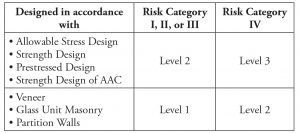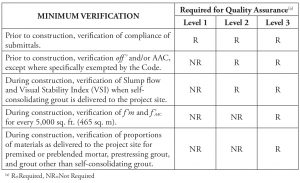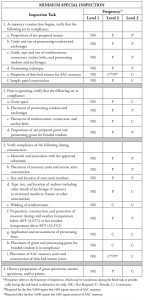Specifying an Effective Quality Assurance Program
The quest for quality construction following a professional design by the Structural Engineer is not a new concept. The initial publishing of the 1927 Uniform Building Code (UBC), subtitled the material disciplines “Quality and Design,” acknowledged the relationship between the design and implementation of a construction project. Over the past 90 years, Quality Assurance, the development of a program, and Quality Control, the implementation of that program, have evolved in such a manner that details can often cloud the ultimate intent.
The development of General Notes by Structural Engineers for specific projects can be a challenging task, particularly regarding issues of Quality Assurance and Quality Control. Conflicts can easily develop between the General Notes, the project Specifications, and the governing Building Code requirements. The development of Quality Assurance and Quality Control provisions contained in the 2016 version of TMS (The Masonry Society) 402/602, Building Code Requirements and Specification for Masonry Structures, can help minimize these potential conflicts and provide design professionals with very helpful tools to increase effective communication with all members of a project team.
History
Although the concept of Quality and Design was introduced in 1927, it was not until the 1943 edition of the UBC that a mechanism was established to implement quality in masonry construction. Section 204 (b)2 stated that masonry must be continuously inspected by a “Registered Inspector” when the stresses exceeded 50 percent of the design stresses allowed by the masonry design chapter. Even though the code required a “thoroughly qualified” registered inspector, there was no direction on what constituted the qualifications or what to inspect.
The next code cycle (1946) required that the registered inspector be qualified by the building official but, other than being qualified, the registered inspector was given little direction on masonry inspection for the next 30 years. Some progress was made in 1976 when the UBC listed when to inspect masonry, such as during placement of masonry units and reinforcement, before and during grouting operations, and preparation of test specimens. Still, the code provided little guidance on the quality control aspects of masonry inspection.
As the code transitioned into the International Building Code (IBC) in 2000, inspection tables were introduced in the IBC and the referenced material standard, Building Code Requirements for Masonry Structures (TMS 402/ACI 530/ASCE 5). Although similar, these inspection tables contained inconsistencies, with the IBC taking a senior position for inspection tasks. Even with the inconsistencies, this was a significant step forward in formulating consistent Quality Control requirements.
For several years, both sets of inspection tables matured. In 2009, the IBC contained a detailed list for two levels of masonry verification and inspection tasks in Tables 1704.3 and 1704.4. These tables formed the basis for developing a Quality Assurance program by listing the minimum Quality Control provisions required for masonry construction. The two sets of tables ultimately disappeared in the 2012 IBC since they were redundant with the Verification and Inspection Tables contained in TMS 402-11/ACI 530-11/ASCE 5-11, Building Code Requirements for Masonry Structures.
Structural Notes
Since the code has historically been lacking specific Quality Assurance and Quality Control provisions, Structural Engineers have been appropriately listing material and construction requirements on structural drawings in the form of General Notes (as supplemented by the project Specifications). For the most part, Masonry General Notes have been a repetitive listing of material standards, such as ASTM C90 for Concrete Masonry Units, ASTM C270 for mortar, and ASTM C476 for grout. In addition to listing the ASTM Standards, some of the material properties contained in the Standards were also listed, such as the strength of the Concrete Masonry Unit, the strength and mix proportion of masonry mortar (which conflicts with the Standard), and the strength of grout.
For example, there can easily be a conflict in the way mortar is listed. That is, an inconsistent requirement for a specified mortar strength and a given proportion mix. Numerous citations in the mortar Standards explain why field-tested mortar is not expected to meet the laboratory mortar strength as listed in ASTM C270. The primary reason is that the water-cement ratio of mortar in the wall is significantly lower after the masonry unit is laid when compared to the water-cement ratio in the test specimen. Another significant factor is that the aspect ratio of the mortar joint in a masonry wall provides a geometric configuration that is considerably stronger than mortar in a test specimen.
It is a customary practice for the Structural Engineer to develop a master-set of General Notes which are intended to be utilized on every project. Of course, each construction project is unique, and the specific circumstances and conditions which are associated with each project must be considered in the application of the master-set of General Notes from project-to-project. Sometimes this does not occur, and General Notes which may be applicable to one project are left intact where different requirements may apply. Further complicating this situation is the ever-changing nature of material standards and code requirements. This is all particularly true with respect to quality assurance and quality control issues. There is, however, a simple approach to circumvent the potential confusion.
TMS 402/602 Requirements
The Building Code Requirements and Specification for Masonry Structures document contains two standards, along with their commentaries:
- Building Code Requirements for Masonry Structures designated as TMS 402 (formerly designated as TMS 402/ACI 530/ASCE 5);
- Specification for Masonry Structures designated as TMS 602 (formerly designated as TMS 602/ACI 530.1/ASCE 6).
These standards are produced by The Masonry Society’s Committee TMS 402/602. The Code covers design and construction of masonry structures, while the Specification is concerned with minimum requirements for masonry construction. The Code contains provisions dealing with Quality Assurance in masonry construction (along with many other topics); the Specification covers subjects such as Quality Assurance and Quality Control in masonry construction.
In general, the Code is written as a legal document, which is suitable for adoption by the IBC; the Specification is written as a master Specification which is required by the Code and is meant to be modified and referenced on a project-specific basis.
TMS 402 Requirements
IBC Section 1705.4 references TMS 402 for Quality Assurance requirements. There are three levels of Quality Assurance in TMS 402. Determination of the minimum quality assurance level is based on both the chosen design methodology and the Risk Category which applies to the project at hand.
The Risk Category is as-defined in IBC Table 1604.5 and, to determine the appropriate Quality Assurance level, the Risk Category is split into two groups. One group (Risk Categories I, II and III) covers most buildings, and the other (Risk Category IV) encompasses critical facilities expected to be operational after a disaster.
TMS 402 contains a simple table for determining the minimum Quality Assurance level applicable for a given project. A modified version of the table is shown in Table 1.
The most typical situation will include a structural design approach which utilizes either Allowable Stress Design or Strength Design, implying that Quality Assurance Levels 2 and 3 will be specified and utilized by the Structural Engineer.
General Notes Simplified
Structural Engineers are rightfully concerned that the project documents, including the General Notes, are complete, coordinated, and clearly communicate the design intent. Utilizing the Quality Assurance tables provided in TMS 602 will not only provide a complete task list for Quality Control but also will deliver a more consistent message for the inspector and contractor to accurately understand what is required to comply with the Quality Assurance plan set forth by the engineer.
The 2016 version of TMS 602 went a step further in combining all Quality Assurance levels into a single table. Now, the Structural Engineer has the option of utilizing the Verification and Inspection tables in their General Notes, in their entirety, with a statement of which Quality Assurance Level (1, 2 or 3) is required for compliance (Tables 2 and 3). When field personnel receive the same set of code-conforming requirements for every job, understanding and applying those requirements will improve dramatically.
The Structural Engineer may enhance the requirements, such as making some of the periodic tasks continuous or scheduling how much periodic inspection is required.
Conclusion
Masonry Verification and Inspection Tables are contained in TMS 602, Specification for Masonry Structures, a consensus document maintained by a balanced committee of users (designers), producers (industry representatives), and general interest stakeholders (academia and others). Committee members spend countless hours developing and maintaining the document, including the Verification and Inspection Tables. Quality Assurance and Quality Control provisions are regularly evaluated and reevaluated to ensure that the provisions harmonize with current applicable Standards and other provisions and that they are published for reference into the model building code. By simply incorporating these tables into the General Notes, the Structural Engineer will have a level of confidence that the intent of the Quality Assurance program will be understood and uniformly applied.■



